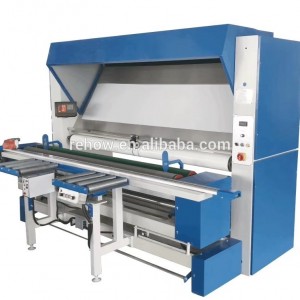Fiberglass window screening cloth inspection and winding machine is widely used in today’s market. Due to the particularity of materials such as glass fiber and window screens, this type of model requires a lot of consideration in production, and of course special attention must be paid to maintenance and maintenance.
图1 :Cloth Inspection and Rolling Machine
To maintain the cloth inspection machine, first of all, it is necessary to carry out regular inspection and timely oil maintenance on all the driving gears and sprockets in the transmission part of the equipment, so as to ensure that the transmission parts of the cloth inspection machine can maintain a good lubrication state. In addition, in the regular inspection, if the parts are found to be seriously worn, they must be replaced in time. Secondly, we need to remove dust, cloth hair debris, etc. in the motor and transmission part of the cloth inspection machine in time. Finally, in the daily use process, we should often clear the dust and cloth debris on the fluorescent tube of the cloth inspection machine and the light-emitting cloth inspection glass plate, so as to effectively ensure the standard lighting of the cloth inspection machine.
About the maintenance of common faults: There are mainly 8 kinds of common faults of the cloth inspection machine. For the causes of these different faults, we provide the following simple maintenance methods for reference.
Fault 1. The fabric is tilted, and “bite dead” occurs when the cloth inspection machine is moving forward: this is mainly caused by the non-parallel cloth guide rollers of the cloth inspection machine. The equipment operator only needs to adjust the parallelism of the cloth guide rollers to solve the problem .
Fault 2. Irregular fabric roll: The uneven fabric roll is caused by the non-parallel fabric roll and guide roller, so adjusting the parallelism between the fabric roll and guide roll can completely eliminate the problem of uneven roll.
Fault 3. The fabric guide and roll of the cloth inspection machine are heavy: the cause of this problem may be that the transmission part of the machine has dust, cloth wool and oil stains, or the transmission parts are not installed properly, as long as we install the transmission of the cloth inspection machine correctly Parts, and regularly clean the oil and cloth hair in the machine.
Fault 4. The machine is noisy: the problem of the machine noise is mostly due to poor lubrication of the machine, wear of parts or loose screws, and some wear and tear of the transmission shaft, resulting in a large gap and left and right movement. We can pass Regularly lubricate the equipment, install various parts correctly, and correct or replace damaged or substandard parts to solve this problem.
Fault 5. The cloth guide roller or the cloth take-up roller will partially stagnate every time it rotates: this phenomenon is mainly caused by the replacement of the bearing and the original parts, and the damage and bending of the cloth guide roller and cloth take-up roller shaft Yes, it can be solved by adjusting the equipment parts that do not fit well, and then correcting the bending deflection of the shaft.
Fault 6. The light brightness of the glass plate of the cloth inspection table is not enough: the light brightness of the glass plate of the cloth inspection table is not bright enough, mainly because there is dust, cloth debris on the fluorescent tube and the glass plate of the cloth inspection table, or the voltage of the lamp tube is unstable. Yes, as long as the dust and cloth debris on the fluorescent tube and the glass plate of the cloth inspection table are removed frequently, and the lighting voltage is stabilized, this problem can be easily solved.
Fault 7. Inaccurate counting length of the double-code device: In the process of conveying the fabric, insufficient friction, long-term use of the long-term wheel wear or obstruction of operation, etc., may cause the problem of inaccurate counting of the double-code device of the cloth inspection machine. We It can be solved by increasing the relative temperature of the cloth to increase the friction of the cloth conveying movement, replacing the length gauge wheel, and cleaning the dust and oil on the length gauge wheel frequently.
Fault 8. Other operating faults: Long-term failure to add lubricating oil will cause other operating faults during the operation of the equipment. It is only necessary to regularly add lubricating oil to the equipment to avoid these faults.
Post time: May-16-2023






